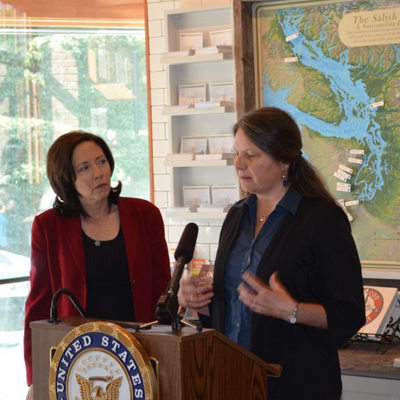|
|
|
|
|
|
Washington Ocean Acidification Center |
Corrosive Waters |
|
|
Ocean acidification happens because on land we release carbon dioxide into the atmosphere. That carbon dioxide comes back into the ocean. You have increased CO2 in the water and the water simply becomes more corrosive.
In 2013 the Washington State legislature appropriated $1.8M to establish the Washington Ocean Acidification Center, co-directed by Jan Newton. The mission is to improve forecasts of where and when corrosive waters may occur and to create mitigation strategies.
|
|
More About This Research
|
 |
|
NANOOS partnerships for assessing ocean acidification in the Pacific Northwest Newton, J., D. Martin, E. Mayorga, A. Devol, R. Feely, S. Alin, B. Dewey, B. Eudeline, A. Barton, and A. Suhbier, "NANOOS partnerships for assessing ocean acidification in the Pacific Northwest," Proc. MTS/IEEE Oceans 2012, 14-19 October, Hampton Road, VA, doi:10.1109/OCEANS.2012.6405086, 2012. |
|
More Info
| |
|
14 Oct 2012 
|
|
 |
|
|
Ocean acidification has serious implications for the economy and ecology of the Pacific Northwest United States. A combination of factors renders the Pacific coast and coastal estuaries particularly vulnerable to acidified water. The Northwest Association of Networked Ocean Observing Systems, NANOOS, the Regional Association of the United States Integrated Ocean Observing System, IOOS, is set up to deliver coastal data to serve the needs and decisions of its region. NANOOS has worked through IOOS with the NOAA Ocean Acidification Program, NOAA PMEL, academic, local, and commercial and tribal shellfish growing partners to provide existing observing assets to accommodate pCO2 and pH sensors, to deliver data streams from these and other providers, including that from sensors in shellfish hatcheries, and to network this capacity regionally and nationally. This increase in data access regarding OA is of value to scientists, managers, educators, and shellfish growers who are especially appreciative of the near real-time readouts of the data, upon which to make hatchery and remote setting decisions. This is a regional example of NANOOS and IOOS contributions to societal impacts from ocean acidification.
|
|
 |
|
NANOOS contributions to understanding ocean acidification in the Pacific Northwest Newton, J.A., A.H. Devol, M.H. Alford, C.L. Sabine, R.A. Feely, S.R. Alin, and B. Hales, "NANOOS contributions to understanding ocean acidification in the Pacific Northwest," In Proceedings, MTS/IEEE OCEANS 2010, Seattle, 20-23 September, doi:10.1109/OCEANS.2010.5664014 (MTS/IEEE, 2010). |
|
More Info
| |
|
20 Sep 2010 
|
|
 |
|
|
NANOOS is coordinating a regional effort to observe the status of ocean acidification in the coastal waters and estuaries of Washington and Oregon. There is strong partnership in this effort between federal and university scientists, as well as strong interest from shellfish growers, tribes, and other stakeholders in the region. NANOOS, as a regional association of US IOOS, can fill a key role in providing regional coordination for observing assets, access to data, and education and outreach regarding this important issue.
|
|
 |
|
The combined effects of ocean acidification, mixing, and respiration on pH and carbonate saturation in an urbanized estuary Feely, R.A., S.R. Alin, J. Newton, C.L. Sabine, M. Warner, A. Devol, C. Krembs, and C. Maloy, "The combined effects of ocean acidification, mixing, and respiration on pH and carbonate saturation in an urbanized estuary," Estuar. Coast. Shelf Sci., 88, 442-449, doi:10.1016/j.ecss.2010.05.004, 2010. |
|
More Info
| |
|
15 May 2010 
|
|
 |
|
|
Puget Sound is a large estuary complex in the U.S. Pacific Northwest that is home to a diverse and economically important ecosystem threatened by anthropogenic impacts associated with climate change, urbanization, and ocean acidification. While ocean acidification has been studied in oceanic waters, little is known regarding its status in estuaries. Anthropogenically acidified coastal waters upwelling along the western North American continental margin can enter Puget Sound through the Strait of Juan de Fuca. In order to study the combined effects of ocean acidification and other natural and anthropogenic processes on Puget Sound waters, we made the first inorganic carbon measurements in this estuary on two survey cruises in February and August of 2008. Observed pH and aragonite saturation state values in surface and subsurface waters were substantially lower in parts of Puget Sound than would be expected from anthropogenic carbon dioxide (CO2) uptake alone. We estimate that ocean acidification can account for 24–49% of the pH decrease in the deep waters of the Hood Canal sub-basin of Puget Sound relative to estimated pre-industrial values. The remaining change in pH between when seawater enters the sound and when it reaches this deep basin results from remineralization of organic matter due to natural or anthropogenically stimulated respiration processes within Puget Sound. Over time, however, the relative impact of ocean acidification could increase significantly, accounting for 49–82% of the pH decrease in subsurface waters for a doubling of atmospheric CO2. These changes may have profound impacts on the Puget Sound ecosystem over the next several decades. These estimates suggest that the role ocean acidification will play in estuaries may be different from the open ocean.
|
|
 |
|
Acidification Eating Away at Tiny Northwest Sea Creatures The Seattle Times, Craig Welch Scientists have documented that souring seas caused by CO2 emissions are dissolving pteropods, a key marine food source. The research raises questions about what other sea life might be affected. |
|
30 Apr 2014 
|
|
 |
 |
|
Ocean acidification center another example of state leading the nation UW News and Information, Sandra Hines Washington's governor and state legislators in the last session created a hub at the University of Washington to coordinate research and monitoring of ocean acidification and its effects on local sea life such as oysters, clams and fish. |
|
More Info
| |
|
8 Aug 2013 
|
|
 |
|
|
Based on what's learned, the center will marshal efforts to improve the ability to forecast when and where corrosive waters might occur and suggest adaptive strategies to mitigate the effects.
"I don't know of any other place in the nation where the state legislature has had the foresight to allocate funding to address these questions," said Terrie Klinger, UW associate professor of marine and environmental affairs, and co-director of the new center with Jan Newton, principal oceanographer at the UW Applied Physics Laboratory.
The UW, which received $1.8 million in state funding for the center's first two years, will work with investigators from other universities such as Western Washington University and with agencies, tribes, the shellfish industry and other organizations to address the needs specified by the legislature.
When the ocean absorbs excess carbon dioxide from the atmosphere it becomes slightly more acidic and can deprive animals such as oysters, clams and crabs of the building materials for their shells. When such animals encounter carbon dioxide-rich waters, particularly in their earliest stages as larvae and juveniles, it can cause poor development or death. (story continues, see link)
|
|
 |
|
Puget Sound is becoming threat to shellfish industry FOX News, Darren Dedo NOAA and the University of Washington are studying the problem through a system of ocean buoys, dozens of them deployed off the Washington and Oregon Coasts. UW professor Jan Newton says the buoys will collect valuable data for scientists. |
|
2 Aug 2010 
|
|
 |
 |
|
Acidic water no surprise to shellfish growers The Olympian Results of a Puget Sound water chemistry study released last week by state and federal scientists confirmed what shellfish growers already fear: The water is turning more acidic. |
|
20 Jul 2010 
|
|
 |
 |
|
New 'ocean acidification' monitoring equipment deployed off LaPush Peninsula Daily News Scientists are optimistic that sophisticated monitors now operating off the North Olympic Peninsula coast will help them understand acidity levels that are skyrocketing both in the ocean and in Puget Sound and Hood Canal. |
|
18 Jul 2010 
|
|
 |
 |
|
Scientists: Acidity in much of the Sound can be lethal The Seattle Post-Intelligencer, Fiona Cohen This week NOAA and the University of Washington's Applied Physics Laboratory will launch a buoy 15 miles of the coast near La Push and equip it with instruments to monitor the weather, the atmosphere, the water chemistry and plankton growth. |
|
12 Jul 2010 
|
|
 |
 |
|
Shellfish at risk: Puget Sound becoming acidified The Seattle Times, Craig Welch Scientists from the University of Washington and the National Oceanic and Atmospheric Administration (NOAA) warned that the changing pH of the seas is hitting Puget Sound harder and faster than many other marine waters. |
|
12 Jul 2010 
|
|
 |
 |
|
State's most sophisticated buoy to sample for acidification, oxygen-starved waters UW News and Information, Sandra Hines The most sophisticated array of instruments ever put in Washington waters has been mounted on a buoy and Seaglider that will be deployed this week off the coast near La Push, in water that typically makes its way into Puget Sound, according to Jan Newton. |
|
12 Jul 2010 
|
|
 |
Related Research at APL-UW
|
Directly Measuring Ocean Acidification
A poster presentation by Robert H. Byrne and Sabine Mecking |
|
 |
|
|
Senator Maria Cantwell Announces Increase in Ocean Acidification Research Funding
|
|
|
On Earth Day, 22 April, Senator Cantwell was at a Seattle shellfish market to announce the continued funding of research into ocean acidification in Washington State. The previous week a key Senate appropriations subcommittee voted to increase — rather than cut — support for the NOAA Regional Integrated Ocean Observing Systems (IOOS), which operate monitoring buoys and sensors in Washington State.
|
|
|
Senator Cantwell’s Earth Day press release
|
|
 |
|
Cantwell announces plan to protect Washington shellfish jobs
A U.S. Senates subcommittee voted to increase rather than cut support for the NOAA Regional Integrated Ocean Observing Systems (IOOS), which operate acidification monitoring buoys and sensors in the state. |
|
 |
Jan Newton, APL-UW Senior Principal Oceanographer and Executive Director of the Northwest Association of Networked Ocean Observing Systems (NANOOS, the PNW Regional IOOS), was on hand for Senator Cantwell's announcement. She explained the effects of increasingly acidified waters on the ocean ecosystem and described how scientists are working to understand the contributions of natural and anthropogenic processes to acidification on the Washington coast and in the Puget Sound basin.
|
NANOOS
Northwest Association of Networked Ocean Observing Systems |
|
 |
Cantwell led an effort with 11 other Senators to urge Senate appropriators to restore support for key ocean acidification monitoring programs that were under threat for elimination in the proposed FY2013 budget. The National Oceanic and Atmospheric Administration's programs allow shellfish growers to monitor ocean acidity in real time, using data from acidification sensors and buoys. With this information, shellfish farmers can avoid filling tanks with seawater when acidity is too high.
|
|





